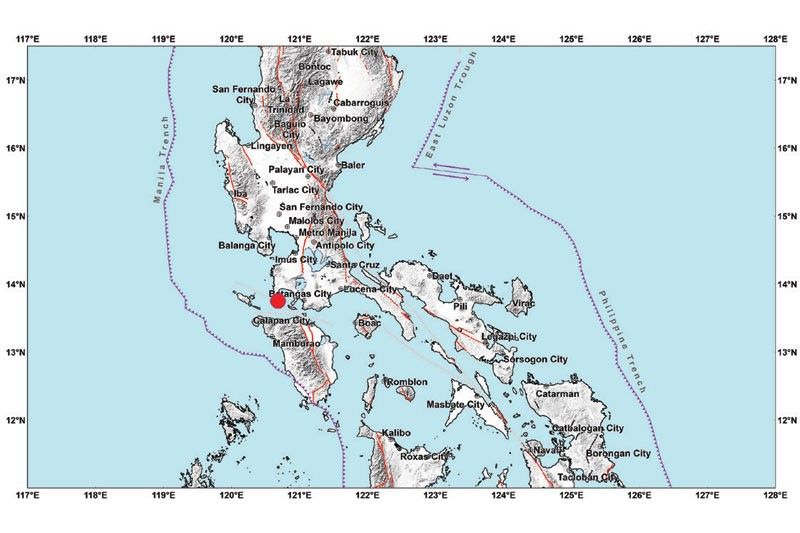Earthshaking Christmas

Strong quakes rock Metro Manila, Davao
MANILA, Philippines — Light railway and train operations in Metro Manila briefly stopped and people attending Christmas morning mass in Calatagan, Batangas had a scare when a 6.3-magnitude earthquake rocked parts of Luzon yesterday.
The temblor struck at 7:43 a.m., with its epicenter traced at 15 kilometers southwest of Calatagan, the Philippine Institute of Volcanology and Seismology (Phivolcs) reported.
It was felt at Intensity 5 – classified by Phivolcs as “strong” – in Calatagan, Balayan, Nasugbu, Batangas City, Calaca and San Luis, all in Batangas province; Tagaytay City, Amadeo, Indang, Kawit and Alfonso, all in Cavite; Lubang and Looc in Occidental Mindoro; and Biñan, Laguna.
Intensity 4 or “moderately strong” was felt in Abra de Ilog and Paluan, Occidental Mindoro; Taal, San Jose, San Pascual, Lemery, Malvar and Ibaan in Batangas; Maragondon and Carmona in Cavite; San Pedro, Laguna; in the cities of Manila, Marikina, Quezon, Pasig and Las Piñas in Metro Manila; Cainta, San Mateo and Antipolo in Rizal province; Obando, Malolos and Meycauayan in Bulacan; Subic and San Felipe in Zambales; Alaminos, Pangasinan; Santo Tomas, La Union, and in the city of Mabalacat, Pampanga.
Intensity 3 was felt in Talisay and Santo Tomas, Batangas; Puerto Galera, Pinamalayan, Naujan, San Teodoro and Calapan, Oriental Mindoro; Caloocan City; Tanay, Rizal; San Jose Del Monte City and Plaridel, Bulacan; San Jose City and Gapan City, Nueva Ecija; Cabangan and Iba, Zambales; Samal, Bataan; Floridablanca and Santa Ana, Pampanga; Valenzuela City; Malabon City.
Intensity 2 was felt in San Isidro, Nueva Ecija; Alaminos City, Pangasinan; Lucban and Guinayangan, Quezon; Doña Remedios Trinidad, Bulacan; and Intensity 1 in Villasis, Pangasinan; and Lucena City, Quezon.
Phivolcs defines quakes of magnitude 3, 2 and 1 as weak, slightly felt and scarcely perceptible, respectively.
The National Disaster Risk Reduction and Management Council (NDRRMC) said there were no reports of casualties as its provincial offices continue to conduct coordination and assessments.
Science Undersecretary and Phivolcs officer-in-charge Renato Solidum Jr. said the tremor was caused by the subduction of Eurasian Plate, part of which is the West Philippine Sea, along the Manila Trench.
“Aftershocks are expected, most of which will not be felt, but we do not discount the possibility of major earthquake events from the Manila Trench,” he said, adding that the quake had a depth of 109 kilometers and was tectonic in origin.
Train systems were briefly immobilized with the Metro Rail Transit Line 3 (MRT-3), Line Rail Transit Line 1 (LRT-1) and Line 2 (LRT-2) and the Philippine National Railways (PNR) announcing that they suspended train journeys moments after the tremor was felt.
The rail systems’ respective engineering, maintenance and safety teams inspected the tracks and facilities and checked if they were damaged by the quake.
Seven PNR trains had to stop running and park at the nearest stations, its management said.
The Light Rail Manila Corp. (LRMC), LRT-1 operator, declared trains had started running again before 9 a.m.
MRT-3 train trips resumed at 8:32 a.m., but with speed reduced to 50 kilometers per hour (kph) from 60 kph. The latter speed was restored past 11 a.m., the management added.
LRT-2 train journeys also restarted at 11:10 a.m., said state-owned operator Light Rail Transit Authority (LRTA).
Meanwhile, a magnitude 5.3 earthquake also hit Sarangani town in Davao Occidental at around 10 a.m. yesterday. It was centered 95 kilometers southeast of the town.
Instrumental Intensity 2 was recorded in Alabel, Sarangani; and Intensity 1 in Kiamba, Sarangani; Koronadal City; and General Santos City.
Instrumental intensity refers to the ground shaking detected by seismic instruments.
Phivolcs warned of possible aftershocks. – Ghio Ong, Romina Cabrera
- Latest
- Trending


























